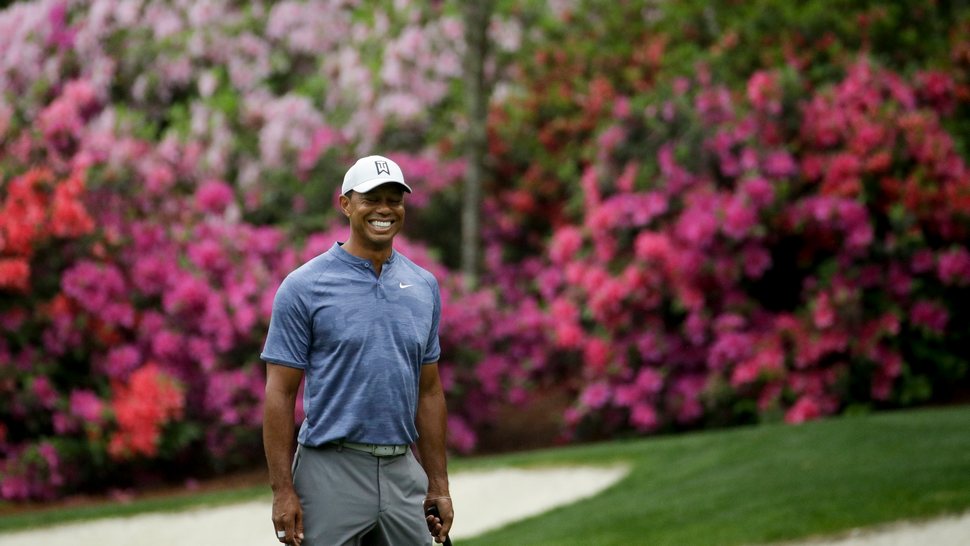Before the explosion of cable and all-sports networks, it was customary for major sporting events to be seen on specific television networks.
The Olympics were the launching pad for ABC Sports, under the guidance of innovator Roone Arledge, who transformed a fledgling network into a future media powerhouse.
For NBC Sports, the broadcast of Major League Baseball and Wimbledon were constants for many years and now the Olympics are part of their marquee staple.
But in today’s ever-escalating bidding war, the movement of sports and the networks that broadcast them has meant a constant state of changes and unpredictability.
Not so with The Masters and its broadcasting partner CBS Sports.
Starting in 1956 and continuing to this day, CBS has served as the USA broadcasting partner for The Masters. Only six cameras and four holes were involved at the outset. The number of cameras now exceeds 100 with a total crew of 650-plus personnel involved with coverage extended to all 18 holes.
From the very beginning, Augusta National Golf Club insisted upon one-year contracts, effectively keeping CBS on a tight leash.
Although the event was the brainstorm of co-founder Bob Jones, it was fellow co-founder Clifford Roberts who orchestrated all the behind-the-scenes actions. Roberts had no desire to knuckle under to non-golf senior executives at a major television network.
It was his determination in bringing to the forefront the many key elements that have elevated Augusta National Golf Club and its annual Masters tournament to near mythic proportions as one of the leading global sports events.
Early on Roberts cultivated relationships with two of the more prominent press people of the day, Grantland Rice and OB Keeler. Both men were enthusiasts of Jones during his zenith playing days. Rice and Keeler used their influence in “spreading the word” with other key sports media, many of whom were coaxed to come to Augusta when returning home from baseball spring training in Florida.
From its early association, Augusta National insisted coverage for The Masters was paramount. Commercial time would be carried out by two agreed-upon sponsors so as not to have the club associated with products of a lesser quality. Dog food, pizza delivery companies and cheeky companies would never be associated with The Masters.

For many years, Cadillac and Traveler’s Insurance were the only two companies involved. And the club insisted commercial time not exceed four minutes per hour.
No other golf event, then or now, commands such continual golf coverage. The reach of The Masters now has six sponsors – Mercedes Benz, AT&T, Rolex, UPS, Delta and IBM. All blue chip, all corporate, all working hand and glove with the club.
Industry analysts have long said Augusta National could reap more money in exchange for a longer-term television deal but for that to happen the penchant for maintaining control would be lessened. However, it is that specific point, controlling the narrative, which remains the uppermost non-negotiable priority.
In addition to the minimisation of commercials CBS cannot mention the prize money for a first-place finish and that includes not stating the total amount of money for the purse. There is no discussion of who Augusta National members are or how one becomes one.
Amazingly, the club was able to maintain a white-only membership for 28 years after Jackie Robinson became the first black player to integrate Major League Baseball. In 1975, Lee Elder broke the color barrier at The Masters. CBS praised Elder’s involvement but nary a word was uttered on why the club took so long in doing so.
With the ubiquitous reach of colour televisions throughout America in the 1960s, the showcasing of the course in all its spring time glory became even more pronounced.
What was said on the air was no less important to the club. In 1966 famed broadcaster Jack Whitaker was banned for several years after describing a crowd of people, walking the fairways, as a “mob” instead of the preferred “patrons” designation.
Years later in 1994 the same punishment befell the irreverent analyst Gary McCord who whimsically said the 17th green was “bikini waxed” and golf balls going over the same green would likely be in “body bags.” McCord became persona non grata and never returned to his duties with CBS at The Masters.
In 2003, protests led by Martha Burk concerning the lack of female members at Augusta National took place and much of the assembled media, golf wise and beyond, paid attention to that storyline. If you were waiting for CBS to discuss the topic during the telecast, you would still be waiting.
When then Masters chairman William “Hootie” Johnson addressed the timeline for the club’s acceptance of female members he bluntly stated Augusta would not be “bullied, threatened, or intimidated. Johnson went further in adding that women may indeed one day be invited to join Augusta, but “not at the point of a bayonet.”
CBS neither spent any time addressing the topic nor opting to interview Johnson on the subject of his inflammatory comments. The role for CBS is always centered on being the club’s eager and ever ready promoter. The probing journalist role would need to fall upon the shoulders of others.
Two women did join Augusta National – Condoleezza Rice and Darla Moore – but not until several years later in 2012.
No matter the internal controls applied, the missing link for Augusta National in its early involvement with television was a captivating storyline. One featuring a golfer that resonated with the public and moved the perception of the sport from being viewed as the bastion of elite blue-bloods.
On cue a chiseled figure from western Pennsylvania emerged. Arnold Palmer took golf to the masses and The Masters hooked up its own ascension in the incredible whirlwind ‘The King’ created when winning four Masters titles between 1958 and 1964.
Palmer built ‘Arnie’s Army’ during The Masters initially through connection to troops stationed at nearby Fort Gordon. That ‘army’ grew rapidly with a range of people and economic levels. Augusta National and the Masters became the launching pad for the sport’s broader mass appeal.

Related: The extended 13th promises to restore Jones and MacKenzie’s vision of a risk-and-reward masterpiece
How ironic a club’s penchant for privacy would provide a setting that ignited the sport’s endearment to a new audience of aspiring golfers.
Television wedded golf, The Masters and Palmer into an overpowering juggernaut. On the heels of Palmer came the long-time dominance of Jack Nicklaus winning a record six titles with the most noted happening in 1986 at age 46. Following Nicklaus came the ascension of Tiger Woods winning five Green Jackets, the last coming epically in 2019. The final round for the 1997 Masters remains the most watched telecast from Augusta National. The event had a 15.8 overnight rating and a 32% share of the audience when Tiger Woods claimed his first Green Jacket.
CBS long realised its continuing association with The Masters provided major prestige and left other networks in a state of envy. Augusta National may someday opt for another television partner but from all accounts the relationship has proven to be like a well-worn slipper for both parties.
Credit Roberts for having the foresight in knowing how to shape a specific visual that inexorably links the sights and sounds that conveys the annual spring-time pageantry of the first Major.
There’s a specific Masters song, with specific lyrics created by Dave Loggins, that remains part and parcel of the telecast although only the theme is now used. Long camera shots panning the property show the spectacular nature and overall beauty of the grounds. Interestingly, bird noises have also been added to the telecast by CBS in order to foster a tranquil and bucolic setting.
Augusta National is the only one of the four Major golf championships played at the same facility each year. That stranglehold has allowed the club to attain a Zeus-like position with all others scurrying below.
Golfers can play Pebble Beach and enjoy it but they yearn for Augusta, even if only to walk the course during The Masters. CBS became the means for The Masters to be viewed as the most sought-after global golf title, even though The Open Championship and the US Open are much older and aligned to the two largest golf associations in the world.
The awarding of the Green Jacket at the end of the telecast in Butler Cabin says it more simply and elegantly than the bestowing of any metallic trophy. The formality of the ritual reinforces a rich tradition with the portrait of co-founder Bobby Jones noticeable in the background.
Roberts and long-time late CBS Golf Executive Producer Frank Chirkinian worked their respective magic in upping the aura to heights unimagined. Chirkinian produced 38 consecutive Masters events and he blended a talented team in front of and behind the camera.
Since 1989, Jim Nantz has been the lead anchor for CBS. Nantz is ably assisted by a range of different commentators who hail from various parts of the globe. Only in recent years, did Augusta National drop its insistence that no CBS reporter follow any of the key groups from within the ropes.
Chirkinian was the brilliant maestro who knew the value of “less is more” in regards to overzealous announcers who simply gum up the works with endless verbal drivel. It was Chirkinian’s fierce total control that meant he had the nickname ‘The Ayatollah’ bestowed on him. His attention to detail elevated The Masters to heights that only the Olympics and World Cup exceeded.
What started in 1934 as a small-time gentleman’s invitational at the behest of golf idol Bobby Jones has been skillfully morphed into a brand of epic proportions. It is The Masters, more than just any player, that commands top billing and CBS is ever resolute in keeping that specific storyline front and centre.
No doubt top tier golf and grand champions through the years have done plenty but the packaging and zealous pursuit in controlling the narrative and shaping what is seen and heard has been nothing short of a Master-piece. No pun intended.
Other sports have desired similarly but The Masters and CBS have created a prototype with benchmarks that set the standards for others to follow.
Madison Avenue attempts daily to churn out fancy slogans and catchy phrases in elevating borderline clients.
The synergy between Augusta National and CBS is truly a marketing Masters class with no equals.
